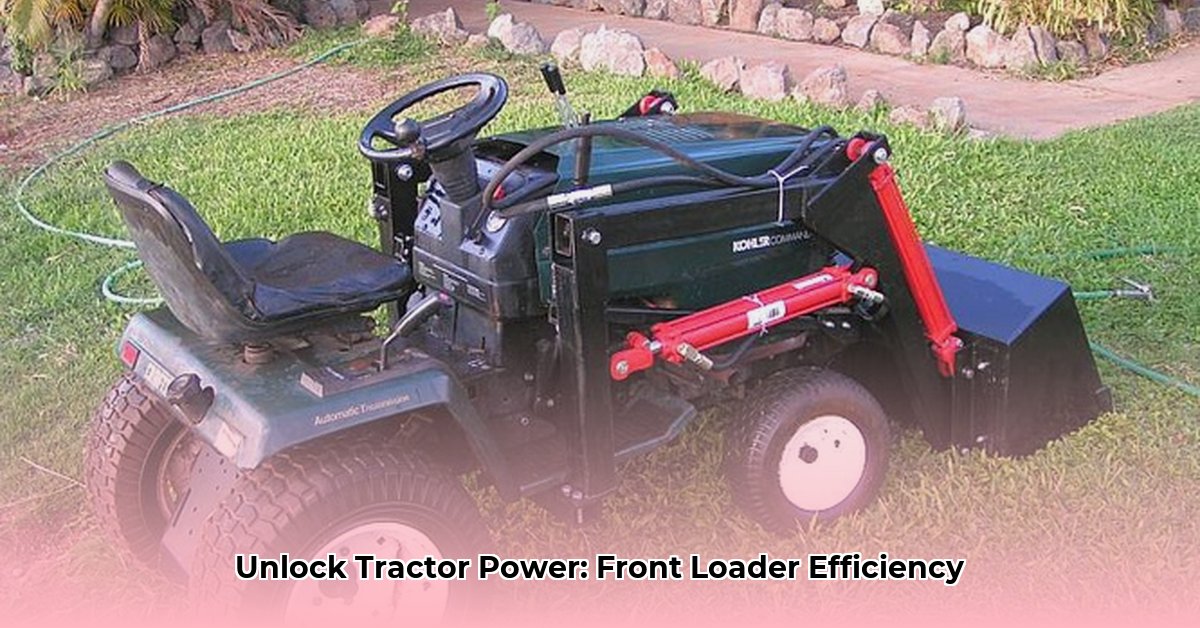
Adding a front loader to your Craftsman tractor dramatically boosts efficiency for various yard tasks. This guide provides a comprehensive walkthrough, covering selection, installation, operation, and maintenance. Whether you're a seasoned DIYer or a novice, we'll equip you to confidently tackle any project. For more information on quick-attach options, see this helpful resource: quick attach forks.
Choosing the Right Front Loader: Scissor Lift vs. Hydraulic
Two primary front loader types exist: scissor lifts and hydraulic loaders. Scissor lifts offer a budget-friendly, simpler installation, suitable for lighter tasks (up to approximately 250 lbs). However, their limited movement restricts precision and heavy-duty applications.
Hydraulic loaders, while pricier and requiring more complex installation, provide superior lift capacity, precision control, and versatility. They excel in heavier tasks and intricate maneuvers. Choosing between them hinges on your needs: lighter material handling favors a scissor lift; heavier or precision work necessitates a hydraulic loader. Don't forget to verify compatibility with your specific Craftsman tractor model. Older models might require custom fabrication or professional assistance.
Key Considerations:
- Lift Capacity: How much weight do you need to lift regularly?
- Maneuverability: Do you need precision control for delicate tasks?
- Budget: How much are you willing to invest upfront?
- Tractor Compatibility: Check the manufacturer's specifications carefully.
Here's a comparison table:
| Feature | Scissor Lift | Hydraulic Loader |
|---|---|---|
| Cost | Lower | Higher |
| Installation | Relatively Easy | More Complex |
| Lift Capacity | Typically up to 250 lbs | Significantly Higher, Model-Dependent |
| Versatility | Limited | Highly Versatile, Numerous Attachment Options |
| Precision | Lower | Excellent |
Installing Your Craftsman Tractor Front Loader: A Step-by-Step Guide
Installing a front loader requires meticulous attention to detail. While steps vary based on the loader and tractor model, always consult the manufacturer's instructions. This general guide provides a framework:
Step 1: Preparation and Safety: Gather necessary tools and materials. Thoroughly review the manufacturer's instructions. Ensure your tractor is on level, stable ground, and the battery is disconnected. Safety is paramount!
Step 2: Mounting the Frame: Carefully align and securely bolt the loader's main frame to your tractor's mounting points. Use the correct bolts and tighten them evenly to avoid frame or tractor damage.
Step 3: Hydraulic Connections (if applicable): For hydraulic loaders, connect hydraulic lines, ensuring a snug fit. Bleed the system to remove air bubbles and check for leaks.
Step 4: Electrical Connections (if applicable): Connect any necessary electrical components for lights or other features, adhering strictly to the manufacturer's guidelines.
Step 5: Testing and Adjustment: Before operating, thoroughly test lift and tilt functions. Verify all safety mechanisms are functional. Minor adjustments might be needed; refer to your manual or seek professional assistance.
Older Tractor Modifications: Adapting a loader to an older Craftsman tractor may necessitate custom fabrication. If you lack experience in welding or metalwork, engaging a qualified mechanic is highly recommended.
Using and Maintaining Your Front Loader: Ensuring Long-Term Performance
Safe operation is critical. Never exceed the loader's maximum lift capacity – overloading could damage the equipment or cause injury. Maintain awareness of the loader's weight and its impact on tractor stability.
Regular maintenance is essential. Inspect hydraulic lines and components regularly for leaks or damage; check fluid levels and condition. Grease and lubricate moving parts as per the manufacturer's recommendations. Preventative maintenance significantly extends the loader’s lifespan.
Dr. Amelia Hernandez, Agricultural Engineering Professor at Purdue University, advises, "Regular inspections are key for preventing costly repairs. Early detection of problems saves time and money in the long run."
Expanding Your Capabilities: Choosing Attachments
Attachments dramatically extend your front loader’s functionality. Consider these popular options:
- Buckets: Various sizes and shapes cater to different material handling needs.
- Toothbars: Enhance digging and breaking up compacted materials.
- Pallet Forks: Streamline pallet handling.
- Snow Blades: Enable efficient snow removal.
Always verify attachment compatibility with your loader model before purchasing. Mismatched attachments can lead to damage or malfunction.
How to Choose the Best Front Loader Kit for My Old Lawn Tractor: A Deep Dive
Choosing the right front loader for an older Craftsman tractor demands careful assessment. Consider these key points:
- Tractor's Horsepower: Ensure adequate power for intended tasks.
- Three-Point Hitch Capacity: It must support the loader’s weight and any future attachments.
- Transmission Type: Hydrostatic or gear transmissions affect operation.
- Fuel Efficiency: Consider the long-term fuel costs.
- Lift Capacity & Cycle Time: Match the loader’s capabilities to your needs.
Remember, a well-chosen loader significantly enhances efficiency and versatility. Prioritize safety, consult your manuals, and seek professional help whenever necessary.